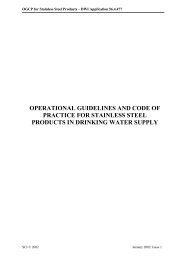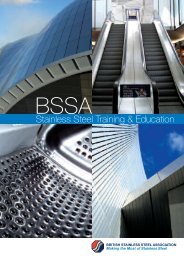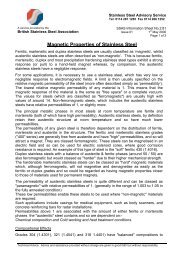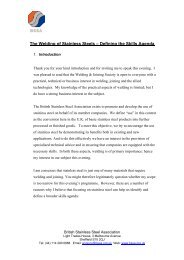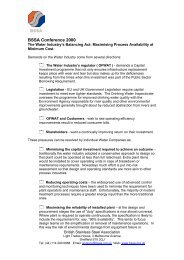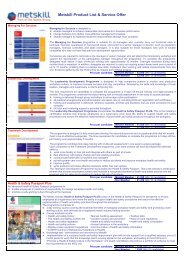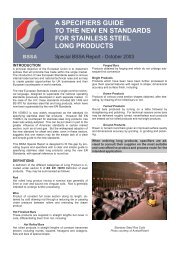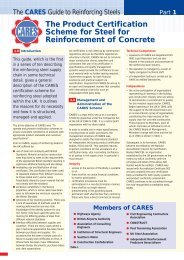The energy benefit of stainless steel recycling - British Stainless ...
The energy benefit of stainless steel recycling - British Stainless ...
The energy benefit of stainless steel recycling - British Stainless ...
Create successful ePaper yourself
Turn your PDF publications into a flip-book with our unique Google optimized e-Paper software.
4<br />
ARTICLE IN PRESS<br />
J. Johnson et al. / Energy Policy ] (]]]]) ]]]–]]]<br />
Table 1<br />
Elemental losses <strong>of</strong> production processes associated with <strong>stainless</strong> <strong>steel</strong><br />
and its alloying elements<br />
Process Losses Source<br />
Chromite mining and separation<br />
losses<br />
17% <strong>of</strong> chromium<br />
mined<br />
Johnson et al.<br />
(2006)<br />
Ferrochromium production losses 20% <strong>of</strong> chromium Johnson et al.<br />
(2006)<br />
Nickel mining and separation losses 20% <strong>of</strong> nickel mined Reck et al.<br />
(2007)<br />
Ferronickel production losses 5% <strong>of</strong> nickel Reck et al.<br />
(2007)<br />
Nickel oxide sinter production<br />
losses<br />
5% <strong>of</strong> nickel Reck et al.<br />
(2007)<br />
Refined nickel production losses Negligible Reck et al.<br />
(2007)<br />
Iron mining and separation losses 19% <strong>of</strong> iron mined Wang et al.<br />
(2007)<br />
Direct reduced iron production<br />
losses<br />
0.43% <strong>of</strong> iron Wang et al.<br />
(2007)<br />
<strong>Stainless</strong>-<strong>steel</strong> smelting in an electric 1.4% <strong>of</strong> entering Johnson et al.<br />
arc furnace<br />
chromium (2006)<br />
0.7% <strong>of</strong> entering<br />
nickel<br />
Reck et al.<br />
(2007)<br />
1.8% <strong>of</strong> entering<br />
iron<br />
Wang et al.<br />
(2007)<br />
the <strong>energy</strong> use results <strong>of</strong> the EIO-LCA findings. <strong>The</strong><br />
remaining 13% includes such items as ‘‘water transportation,’’<br />
‘‘paper and paperboard mills,’’ and ‘‘petroleum<br />
lubricating oil and grease manufacturing,’’ which were<br />
determined to be outside the scope <strong>of</strong> this analysis. It is<br />
important to note that this study captures the first-degree<br />
<strong>energy</strong> use; it does not, for example, account for the <strong>energy</strong><br />
use to make <strong>steel</strong> that is used in the construction <strong>of</strong> the<br />
capital equipment at a <strong>stainless</strong>-<strong>steel</strong> smelter. <strong>The</strong>refore, it<br />
can be estimated that this study captures, at most, 87% <strong>of</strong><br />
the life cycle primary <strong>energy</strong> use.<br />
It is essential when quantifying <strong>energy</strong> use to consistently<br />
look at the primary <strong>energy</strong>. To do so, it was necessary to<br />
link electricity consumption with the fuel needed to<br />
generate that electricity. On a country-level basis, electricity<br />
generation data and fuel consumption rates (International<br />
Energy Agency, 2004a, b) were used to calculate the<br />
country-wide efficiency <strong>of</strong> electricity generation. <strong>The</strong><br />
International Energy Agency’s hybrid substitution method<br />
was employed, meaning that hydropower was assumed to<br />
be 100% efficient and the substitution equivalence (i.e., the<br />
efficiency <strong>of</strong> fossil fuel-based generation) was assumed for<br />
other non-fuel-based generation means. In addition, the<br />
<strong>energy</strong> required in the production, refining, and transportation<br />
<strong>of</strong> coal, petroleum, and natural gas is accounted for,<br />
using the results <strong>of</strong> three studies by the National Renewable<br />
Energy Laboratory that detailed the life-cycle impacts<br />
<strong>of</strong> these fuels (Sheehan et al., 1998; Spath et al., 1999;<br />
Spath and Mann, 2000.<br />
To quantify the <strong>energy</strong> required for mining and<br />
beneficiation processes, several data sources were used.<br />
Anecdotal evidence <strong>of</strong> mine blasting showed that approximately<br />
6 ton <strong>of</strong> explosives are required to mobilize<br />
30,000 ton <strong>of</strong> rock (Bergstrom, 2005). Assuming an <strong>energy</strong><br />
content <strong>of</strong> 2.7 MJ/kg <strong>of</strong> TNT (note: 1 MJ ¼ 10 6 J),<br />
relatively small <strong>energy</strong> expenditures result; although much<br />
power is required during the blast, it is only needed over a<br />
short period <strong>of</strong> time. Liquid fuel use for heavy equipment<br />
was estimated using data from a generic mine provided<br />
by Western Mine (2006). <strong>The</strong> data stated that 1.1 l <strong>of</strong><br />
diesel fuel was required per ton <strong>of</strong> ore, with an assumed<br />
lower heating value <strong>of</strong> 128,400 BTU/gallon, resulting in<br />
38 MJ/ton ore.<br />
For chromite beneficiation, it was found that the<br />
concentrator requires 40 kWh/ton <strong>of</strong> ore feed and the<br />
grinder uses 10 kWh/ton <strong>of</strong> mill feed (Bergstrom, 2005).<br />
Iron mining was shown to require approximately 87 MJ/<br />
ton ore, predominately in liquid fuels, and beneficiation<br />
used 12.4 MJ/ton ore in electricity (US Department <strong>of</strong><br />
Energy, 2002). Nickel mining processes differ for sulfide<br />
and laterite ores; in this model, it is assumed that refined<br />
nickel was produced from sulfide ores and ferronickel and<br />
nickel oxide sinter were produced from laterite ores. Data<br />
for diesel and electricity use during nickel mining and<br />
concentrating were taken from a study by Norgate and<br />
Rankin (2000). Although the primary data sources used in<br />
this study were from the early 1990s, nickel mining and<br />
concentrating are minor contributors to the overall <strong>energy</strong><br />
used in <strong>stainless</strong>-<strong>steel</strong> production, so this is not believed to<br />
have a significant effect on the final results. Country-level<br />
production rates for chromium, iron, and nickel, used to<br />
determine the primary fuel associated with electricity<br />
generation, were taken from the International Chromium<br />
Development Association (2006) and the United States<br />
Geological Survey (USGS) (Jorgenson and William, 2003;<br />
Kuck, 2005).<br />
Ferrochromium production involves four major production<br />
methods: traditional, Outokumpu, Premus, and DC<br />
arc. <strong>The</strong> total production share by mass <strong>of</strong> these methods<br />
was estimated to be 60%, 25%, 10%, and 5%, respectively.<br />
Electricity demands for each technology were assumed to<br />
be 4.0, 3.3, 2.4, and 4.8 MWh/ton <strong>of</strong> FeCr and reductant<br />
(e.g., coke) demands were 0.60, 0.52, 0.20, and 0 ton coke/<br />
ton <strong>of</strong> FeCr, respectively (Daavittila et al., 2004; McLaughlan,<br />
2006; Niemela¨, 2001). A lower heating value <strong>of</strong><br />
28.8 MJ/kg coke was assumed (United States Geological<br />
Survey, 2006) and country-level FeCr production data were<br />
taken from ICDA (2006).<br />
<strong>The</strong> average electricity, coal, oil, and natural gas<br />
consumption for six ferronickel producers were used<br />
(Kerfoot, 2002). To quantify the <strong>energy</strong> used to produce<br />
refined nickel, the results for matte production were added<br />
to nickel refinery data (Kerfoot, 2002). Laterite smelting<br />
unit <strong>energy</strong> was a based on a comprehensive survey <strong>of</strong><br />
global smelters (Warner et al., 2006). Data for nickel oxide<br />
sinter production were taken from a life-cycle assessment<br />
conducted by the Nickel Institute (2006) <strong>The</strong> results <strong>of</strong> this<br />
life-cycle assessment were also used to check the accuracy<br />
<strong>of</strong> the ferronickel and refined nickel calculations; the results<br />
Please cite this article as: Johnson, J., et al., <strong>The</strong> <strong>energy</strong> <strong>benefit</strong> <strong>of</strong> <strong>stainless</strong> <strong>steel</strong> <strong>recycling</strong>. Energy Policy (2007), doi:10.1016/j.enpol.2007.08.028



